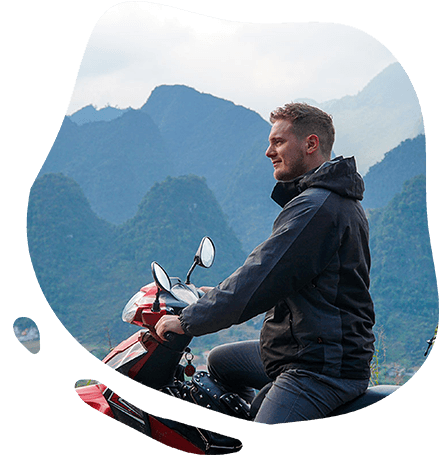Was dich erwartet
Wenn du dich auf eine Trekkingreise in Sapa begibst, erkundest du eine der wohl schönsten Reisfeldlandschaften in Vietnam, wenn nicht sogar in ganz Asien. Die Trekkingrouten schlängeln sich durch Wege, die sich an die Konturen der terrassierten Reisfelder schmiegen und spektakuläre Aussichtspunkte über die Täler eröffnen.
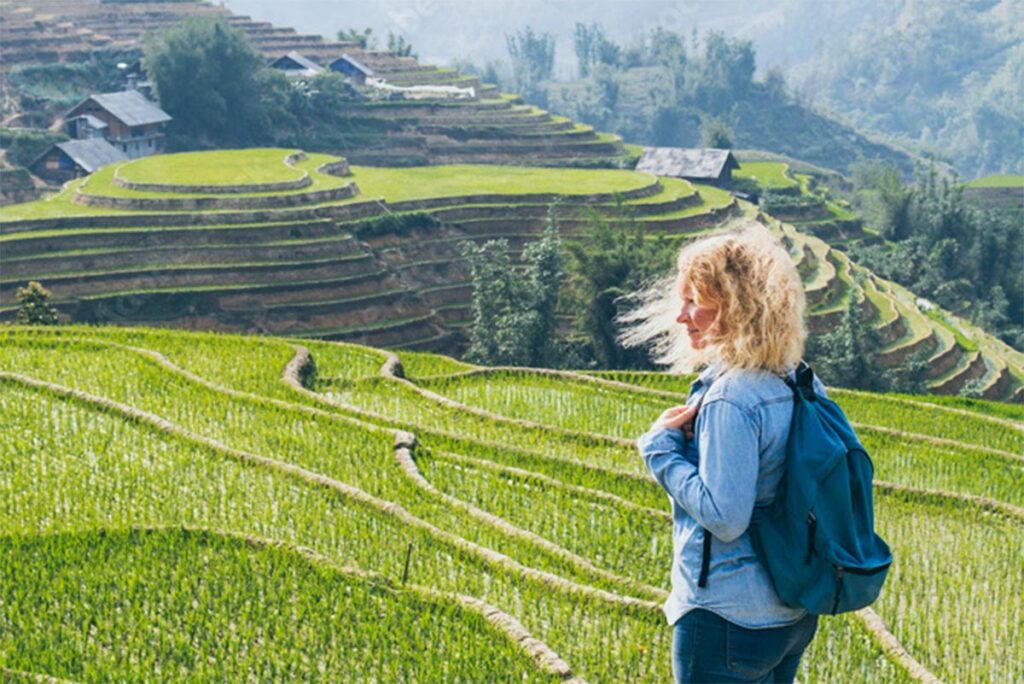
Während du diese Pfade durchwanderst, wirst du auf mehrere Dörfer stoßen, die von ethnischen Minderheiten bewohnt sind. Diese Begegnungen bieten dir einen Einblick in eine Lebensweise, die sich über die Zeit hinweg kaum verändert zu haben scheint. Das Beobachten der lokalen Minderheiten, wie sie in traditioneller Kleidung ihre Felder und Dörfer bewirtschaften, verleiht dem Erlebnis eine tiefgehende Authentizität.
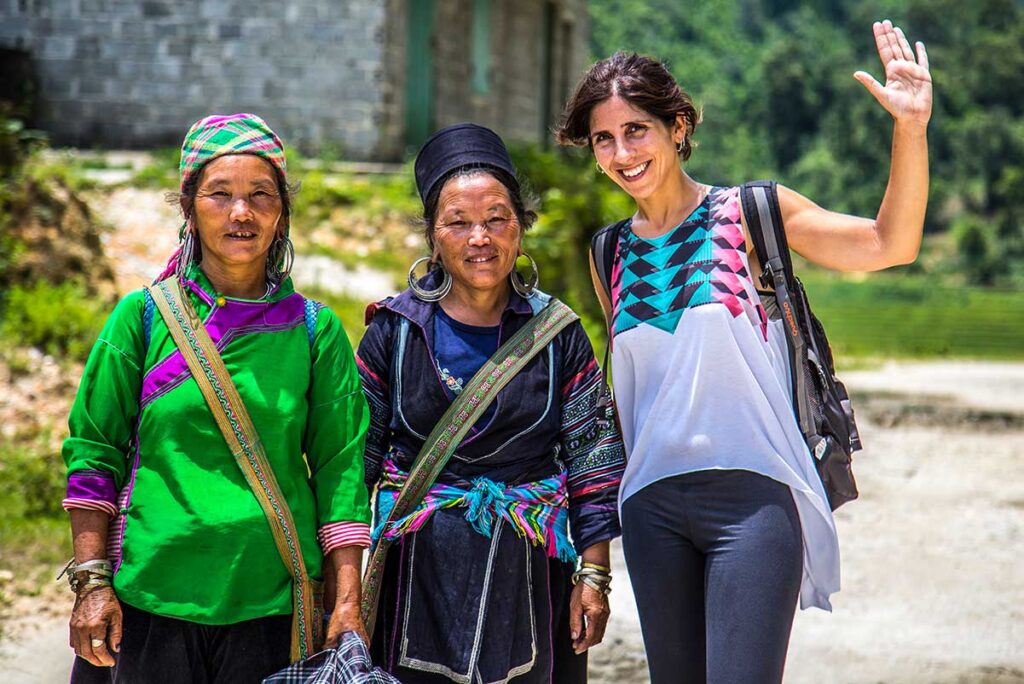
Es ist nicht ungewöhnlich, dass du auf Wasserbüffel triffst, die in diesen Gebieten eine wichtige Rolle in der Landwirtschaft spielen. Sie arbeiten gemächlich auf den Feldern und tragen zur einzigartigen Atmosphäre der Region bei. Trekking in Sapa ist nicht nur ein Fest für die Augen, sondern auch eine lehrreiche Reise, die dir unschätzbare Einblicke in die Kultur und das tägliche Leben der ethnischen Gemeinschaften bietet.
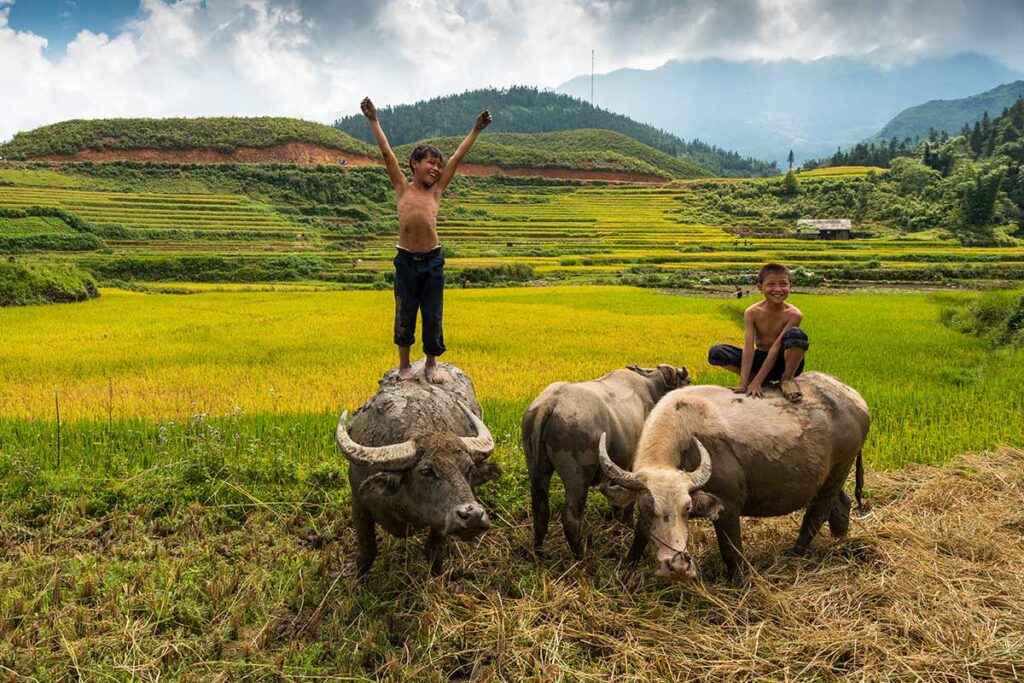
Die beste Zeit für Trekking in Sapa
Die Wahl der richtigen Zeit für das Trekking in Sapa ist entscheidend für ein angenehmes Erlebnis, da die unterschiedlichen Jahreszeiten der Region jeweils einzigartige Perspektiven und Bedingungen für Wanderer bieten.
- Beste Wetterbedingungen für Trekking: Die idealen Monate für Trekking in Bezug auf das Wetter sind während des Herbsts und des Frühlings. In diesen Jahreszeiten ist die Wahrscheinlichkeit für Regen geringer, und die Temperaturen sind angenehm kühl, sodass extreme Hitze oder Kälte vermieden werden. Klare Himmel sind häufiger, was die besten Bedingungen für Wanderungen und den Genuss der Aussicht bietet.
- Die beeindruckendsten Landschaften: Das Ende August und der Beginn September markieren die Reiserntezeit. Obwohl es die Regenzeit ist und das Wetter heißer sein kann, verwandeln sich die Landschaften in atemberaubende goldgelbe Reisfelder und bieten epische Szenerien für Trekking-Enthusiasten.
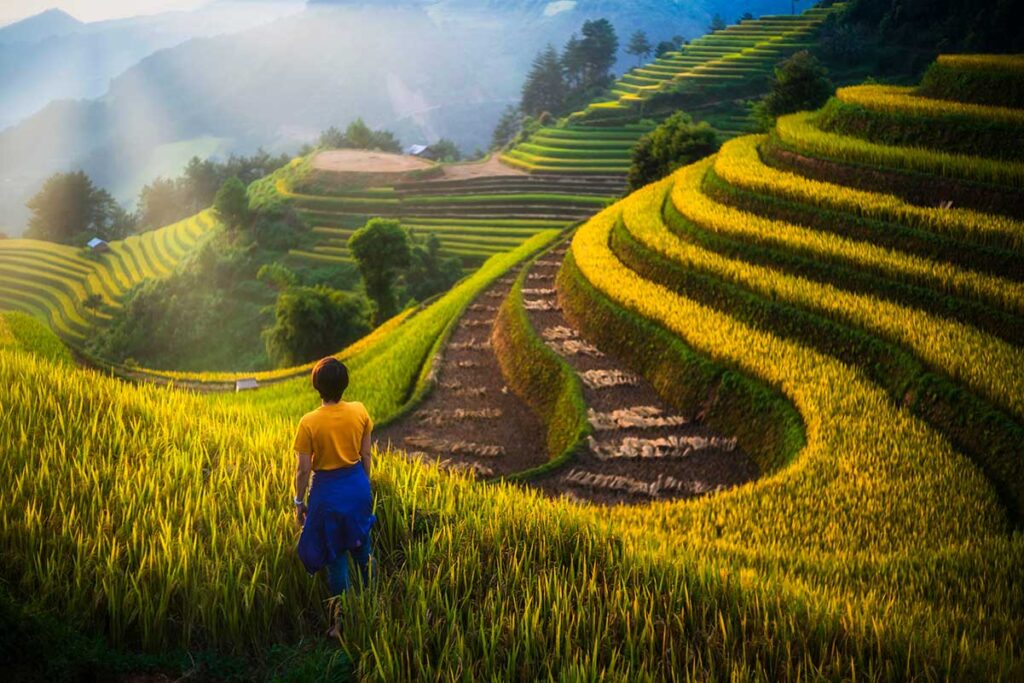
Frühling (März – Mai)
Der Frühling bietet sehr günstiges Wetter für Trekking, mit Temperaturen, die weder zu heiß noch zu kalt sind, und minimalem Regen. Auch wenn die Reisfelder noch nicht sichtbar sind, da das Pflanzen im Mai beginnt, erzeugen die im Wasser versunkenen Felder einen atemberaubenden Spiegeleffekt und bieten eine einzigartige Trekking Kulisse.
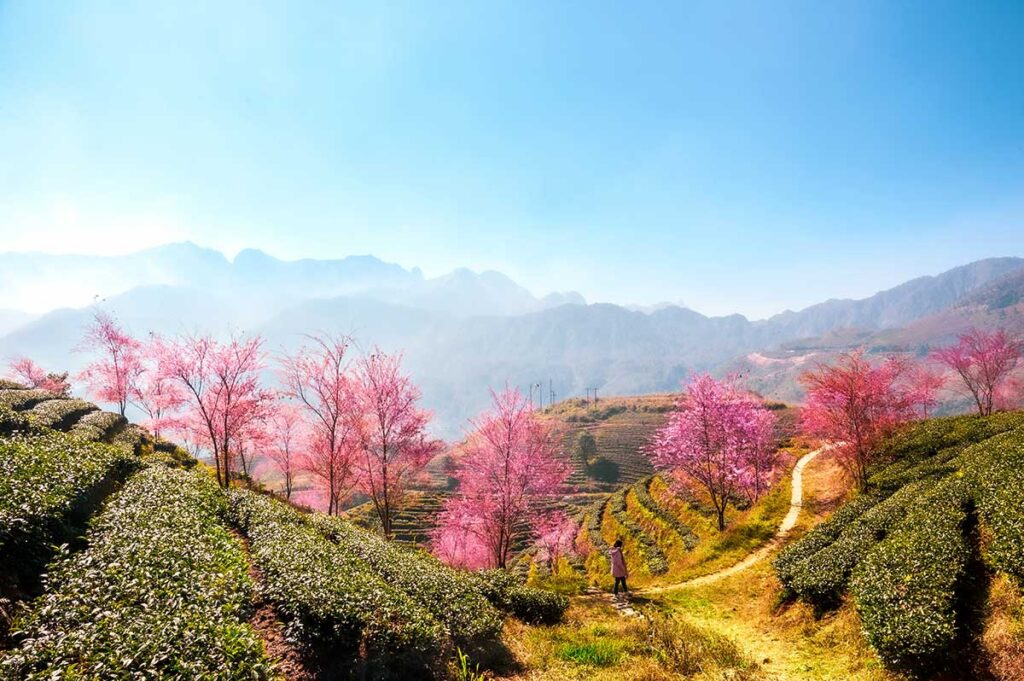
Sommer (Juni – August)
Die Sommermonate bringen die Regenzeit und wärmere Temperaturen nach Sapa. Es regnet jedoch nicht ständig, und die Landschaft beginnt zu erblühen. Ab Juni werden die Reisfelder üppig grün und erreichen ihre volle Schönheit im August. In einigen Gebieten kann die Ernte Ende des Monats beginnen, was die Landschaft von grün zu goldenen Tönen verwandelt.
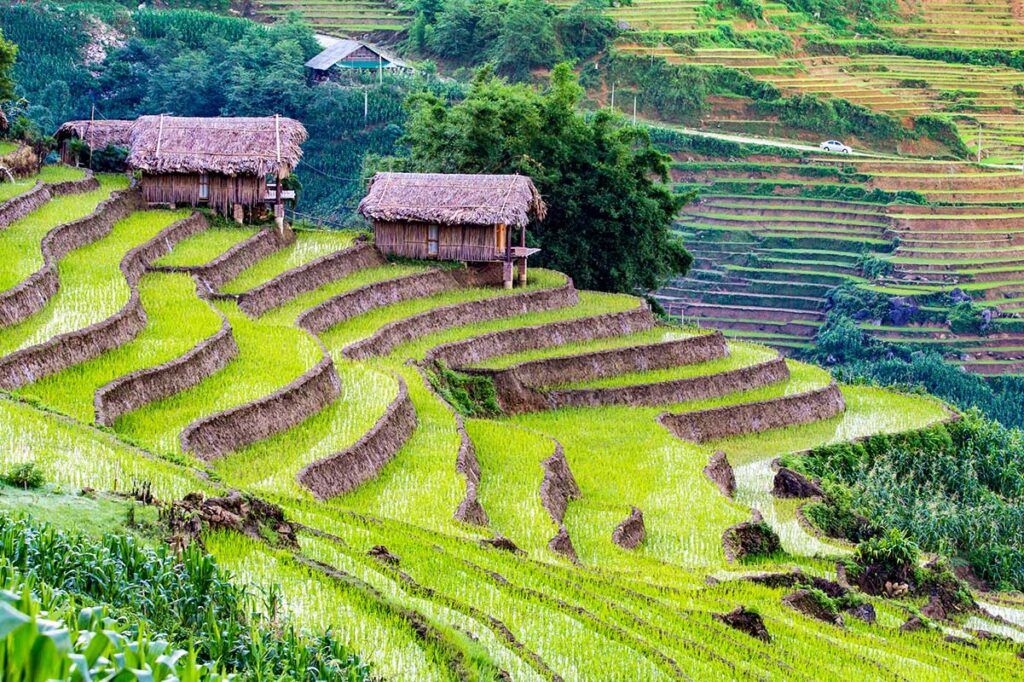
Herbst (September – November)
Der Herbst, besonders der Beginn des Septembers, fällt oft mit der Reisernte zusammen und ist daher wohl die beste Jahreszeit, um Sapa zu besuchen. Die goldenen Reisfelder bieten eine spektakuläre Kulisse für Wanderer. Nach der Ernte könnten die Felder leer sein, aber das Wetter bleibt ideal für Trekking – kühl, angenehm und am Ende der Regenzeit, was klare Himmel und angenehme Bedingungen für Outdoor-Aktivitäten bietet.
Winter (Dezember – Februar)
Der Winter in Sapa ist kalt und oft neblig, was ihn zur am wenigsten günstigen Jahreszeit für Trekking macht. Die Sicht kann durch den Nebel eingeschränkt sein, und die niedrigeren Temperaturen können das Trekking weniger komfortabel machen.

Trekking-Optionen in Sapa
1. Ein Tag oder mehrere Tage
Sapas Landschaft ist ein Paradies für Wanderer und bietet zahlreiche Routen, die sowohl für Tagesausflüge als auch für mehrtägige Trekkingtouren geeignet sind. Eine Tageswanderung kann die Hauptattraktionen des Sapa-Trekkings umfassen: die atemberaubenden terrassierten Reisfelder und die reiche Kultur der ethnischen Minderheiten.
Eine mehrtägige Trekkingtour bereichert das Erlebnis jedoch noch mehr. Sie ermöglicht nicht nur eine Übernachtung in einem authentischen Homestay bei ethnischen Gruppen, was eine tiefere kulturelle Einbindung bietet, sondern auch das Erkunden abgelegener Pfade und das Erleben weniger touristischer Gebiete.
2. Geführte Wanderung oder auf eigene Faust
Unabhängiges Trekking ist möglich, besonders wenn du von einem Dorf im Muong Hoa Valley startest und mithilfe von Google Maps zwischen den Dörfern navigierst. Während die Routen relativ einfach sind, können die Logistik wie Transport zum Startpunkt, Verpflegung während der Wanderung und Abholung am Ende herausfordernd sein.
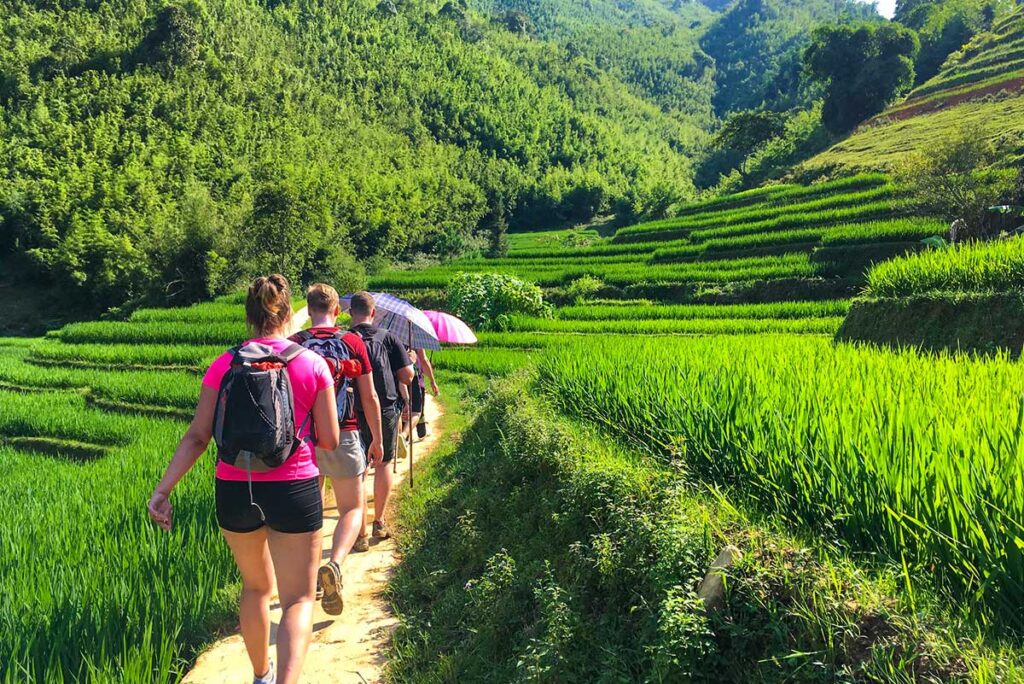
Ein lokaler Guide bietet ein angenehmeres und sorgenfreies Erlebnis. Ein Guide kümmert sich nicht nur um die logistischen Aspekte wie Transfers und Mahlzeiten, sondern bereichert die Wanderung auch, indem er dich von den Hauptpfaden durch die Reisfelder führt, Einblicke in die einzigartige Kultur der ethnischen Minderheiten gibt und die Interaktion mit den Einheimischen erleichtert.
3. Schwierigkeitsgrade und Distanzen
Der physische Anspruch des Trekkings in Sapa variiert. Die Pfade beinhalten normalerweise sanfte Auf- und Abstiege statt steiler Anstiege, was sie für viele zugänglich macht. Abseits der ausgetretenen Pfade können die Routen jedoch bei nassen Bedingungen schlammig und rutschig werden, was die Schwierigkeit erhöht.
Der Hauptfaktor, der die Herausforderung des Trekkings beeinflusst, ist die zurückgelegte Strecke. Die Wanderungen können von kurzen Spaziergängen von 2 bis 5 km bis zu längeren Routen von bis zu 18 km an einem Tag reichen, sodass sie unterschiedlichen Fitnessniveaus und Interessen gerecht werden. Mit einem privaten Guide können die Wanderungen noch weiter angepasst werden, einschließlich der Möglichkeit, die Strecke zu verkürzen, falls nötig, da Abholungen von den Hauptdörfern entlang der Route arrangiert werden können.
Sapa Homestay Trekking
Wir haben es bereits kurz erwähnt, aber lass uns genauer darauf eingehen, was dich bei einer mehrtägigen Trekkingtour mit einer Übernachtung in einem Homestay erwartet, der von einer lokalen ethnischen Familie in Sapa geführt wird. Diese Erfahrung wird oft als eines der Highlights von Sapa beschrieben.

Die Homestays hier sind ziemlich einfach und es fehlt an Luxus und Komfort, obwohl sie mit westlichen Toiletten, Duschen und Moskitonetzen ausgestattet sind. Abgesehen von diesen grundlegenden Annehmlichkeiten, solltest du deine Erwartungen nicht zu hoch setzen. Was an Luxus fehlt, wird durch reiche kulturelle Erfahrungen mehr als wettgemacht. Du lernst direkt von der ethnischen Familie, die dich beherbergt, siehst ihre traditionellen Kochmethoden an offenen Feuern und bekommst einen intimen Einblick in ihre traditionellen Häuser, die dich in eine andere Zeit versetzen. Du tauchst in ihr tägliches Leben ein, isst abends mit der Familie und teilst vielleicht sogar ihren Reisschnaps. Einige ethnische Gruppen bieten das zusätzliche Erlebnis eines traditionellen Kräuterbades.
Diese Erfahrung zu akzeptieren bedeutet, deine Komfortzone zu verlassen, aber genau dieser Schritt bereichert dein Abenteuer in Sapa und macht es absolut lohnenswert.
Die besten Wanderrouten
Muong Hoa Valley: Das Trekking-Zentrum
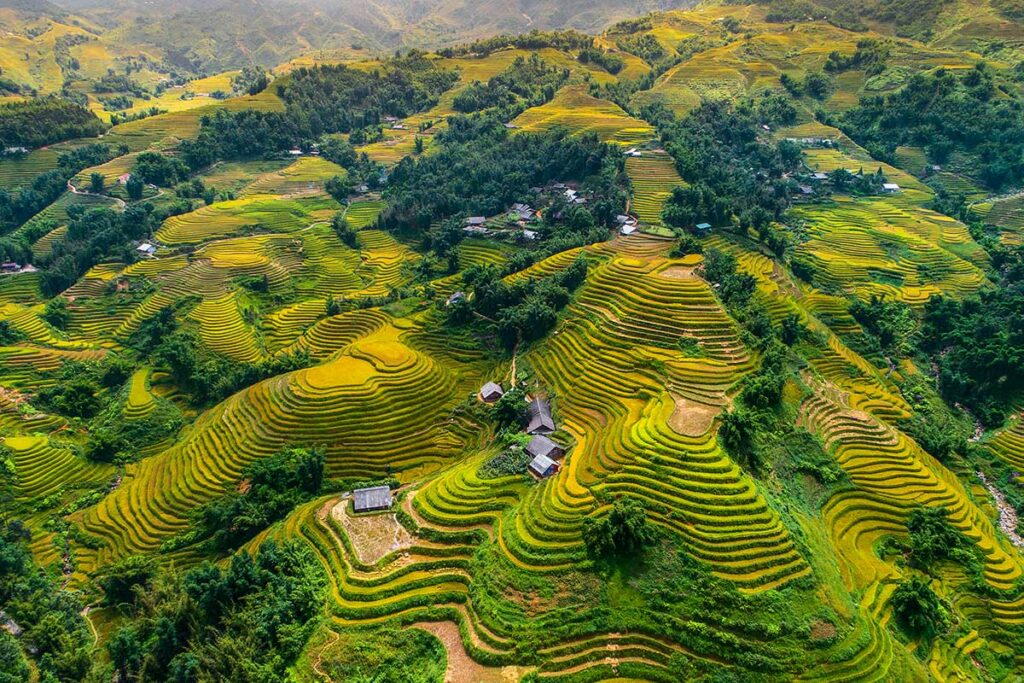
Das Epizentrum des Trekkings in Sapa ist das Muong Hoa Valley, durchzogen von einer Hauptstraße, die mit Autos befahrbar ist und in kleinere Straßen abzweigt, die in die im Tal gelegenen Dörfer führen. Von diesen Dörfern aus beginnen zahlreiche Trekking Abenteuer.
Cat Cat Village: Der Einstiegstrekk
Das Cat Cat Village, nur einen Steinwurf von Sapa entfernt, dient vielen als Einsteigerwanderung. Obwohl kurz und landschaftlich reizvoll, wird das Dorf Cat Cat oft für seine mangelnde Authentizität kritisiert, da es mehr zu einer Touristenattraktion geworden ist als zu einem echten ethnischen Erlebnis.
Y Linh Ho, Lao Chai und Ta Van: Die klassische Route
Wenn du tiefer ins Tal vordringst, triffst du auf die Dörfer Y Linh Ho, Lao Chai und Ta Van. Das Wandern zwischen diesen Dörfern ist äußerst beliebt und bietet einen Einblick in das Herz des Tals, das von weitläufigen terrassierten Reisfeldern geschmückt ist. Diese Gebiete sind leicht zugänglich und gelten als die malerischsten Teile des Tals.
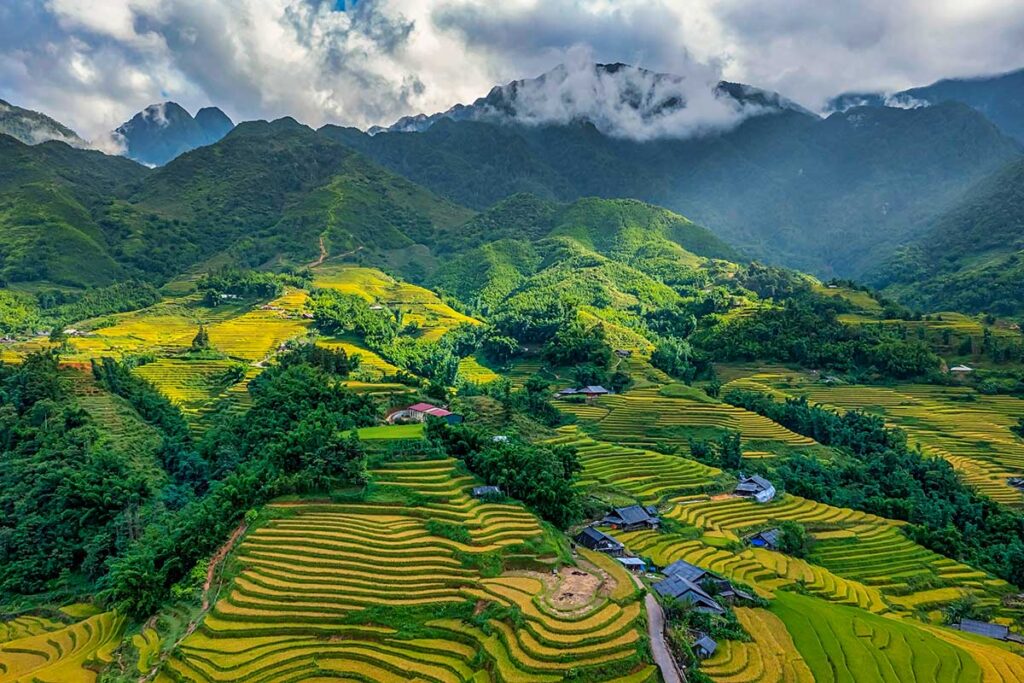
Su Pan und Ban Den: Abseits der Pfade
Weiter von Sapa entfernt liegen die Dörfer Su Pan und Ban Den in weniger frequentierten Gebieten und bieten eine ruhigere Erfahrung. Obwohl ihre terrassierten Felder nicht so groß sind wie die näher bei Sapa, bieten ihre Schönheit und Ruhe einen überzeugenden Grund, sie zu erkunden.
Jenseits des Tals: Ta Phin und Bac Ha
Wenn du außerhalb des Muong Hoa Valley erkunden möchtest, bieten das Ta Phin Village und das entfernte Bac Ha, bekannt für seinen bedeutenden Minderheitenmarkt, weitere Trekking Möglichkeiten. Diese Orte bieten eine Veränderung der Landschaft und einen tieferen Einblick in die ethnische Vielfalt der Region.
Fansipan Trekking
Das Trekking zum Gipfel des Fansipan, dem höchsten Berg Vietnams, ist eine ehrgeizige Alternative. Normalerweise eine 2- oder 3-Tages-Tour, können erfahrene Kletterer es an einem Tag bewältigen, mit Übernachtungsoptionen in einem Dorfcamp.
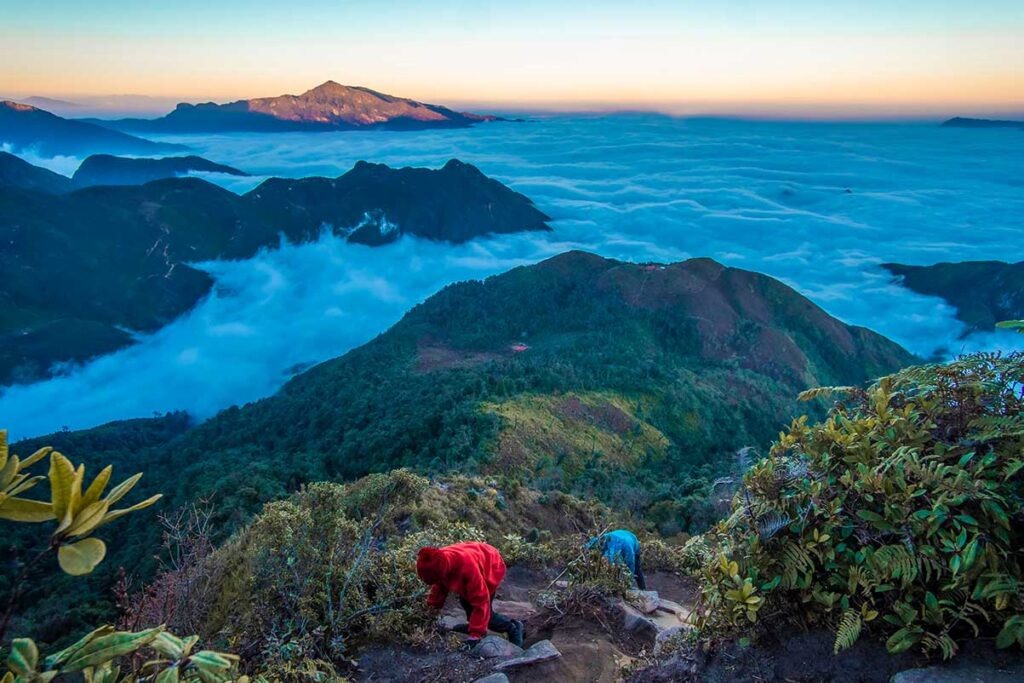
Aufgrund der Verfügbarkeit einer Seilbahn zum Gipfel hat das Trekking etwas von seinem Reiz verloren. Bei begrenzter Zeit werden Talwanderungen über Fansipan empfohlen, da sie durchgehend malerische Ausblicke und kulturelle Begegnungen bieten, während der Gipfel oft wolkenverhangen ist und potenzielle Ausblicke verdeckt.
Wie du deine Trekking Tour in Sapa arrangierst
1. Online Buchung
Deine Trekkingtour online über ein lokales Reisebüro wie Local Vietnam zu buchen, ist eine bequeme Option. Wir bieten maßgeschneiderte Touren an, die auf deine Vorlieben zugeschnitten sind, ob du eine private Tour suchst oder dich einer Gruppe anschließen möchtest. Du kannst die Gebiete angeben, die du erkunden möchtest, die Strecke, die du bequem wandern kannst, und mehr.
Zusätzlich können wir Transportoptionen nach und von Sapa einbeziehen, sei es der Nachtzug oder ein komfortabler Limousinenbus. Für ein umfassenderes Erlebnis solltest du in Erwägung ziehen, Aktivitäten wie den Besuch eines ethnischen Marktes hinzuzufügen oder einen Tag einzuplanen, um durch die Stadt Sapa zu schlendern und mit der Seilbahn den Fansipan zu erklimmen.
2. Buchung in Hanoi
Wenn du noch in Hanoi bist, ist die Organisation deines Trekkings über eines der zahlreichen Reisebüros in der Stadt eine weitere praktikable Route. Allein im Stadtzentrum gibt es über hundert Agenturen. Es ist jedoch wichtig, vorher zu recherchieren; überprüfe die Reiseroute, lies Bewertungen und überprüfe den Namen der Agentur. Sei vorsichtig bei Agenturen, die die Namen renommierter Unternehmen nachahmen, um von ihrem Ruf zu profitieren, ohne den gleichen Servicestandard zu bieten.
3. Organisation in Sapa
Die letzte Option ist, deine Wanderung bei deiner Ankunft in Sapa zu buchen. Praktisch jedes Hotel in Sapa bietet Trekking-Arrangements an, was es einfach macht, eine Tour in letzter Minute zu organisieren. Zusätzlich könnten dich lokale ethnische Guides ansprechen, wenn du durch die Stadt gehst, und dir Trekkingtouren anbieten. Diese direkte Methode ermöglicht spontane Planung und die Möglichkeit, die Wanderung direkt mit den lokalen Guides nach deinen Interessen auszuhandeln oder anzupassen.
Was du mitbringen solltest
Wesentliche Ausrüstung
- Gute Wanderschuhe: Sapa könnte dein einziges Trekkingziel in Vietnam sein, also sind schwere Wanderstiefel nicht notwendig. Wähle bequeme, wasserdichte Wanderschuhe, besonders während der Regenzeit.
- Regenmantel: Statt einer dicken Jacke trage Schichten, um dich leicht an Temperaturänderungen anpassen zu können und Überhitzung während der Wanderungen zu vermeiden. Ein Regenmantel bietet auch Schutz vor Wind.
- Kleine Erste-Hilfe-Ausrüstung: Packe ein Set für kleinere Verletzungen und Blasen sowie Medikamente für häufige Beschwerden wie Erkältung, Durchfall und Fieber.
- Snacks: Obwohl organisierte Wanderungen oft Mahlzeiten beinhalten, sind zusätzliche Snacks für Energie wichtig, da es unterwegs nur wenige Möglichkeiten gibt, Lebensmittel zu kaufen.
- Wasserdichter Rucksack: Ein Muss, um deine Sachen trocken und sicher zu halten, besonders wichtig zum Schutz wertvoller Gegenstände bei Regen.
- Insektenschutzmittel: Unverzichtbar, um Mücken und andere Insekten abzuwehren.
- Kamera: Denke an Ersatzbatterien oder eine Powerbank, um deine Kamera oder dein Telefon aufzuladen, da die Lademöglichkeiten während der Wanderung begrenzt sind.
Zusätzliche Vorschläge
- Zusätzliche Kleidung: Auch auf einer Tageswanderung ist es ratsam, Wechselkleidung mitzunehmen, falls du schwitzig oder nass wirst.
- Badesachen: Falls deine Route an einem Bach vorbeiführt, der sich zum Schwimmen eignet, wirst du froh sein, sie dabei zu haben.
- Handdesinfektionsmittel: Um die grundlegende Hygiene zu wahren, besonders beim Essen in einfachen Einrichtungen.
Für mehrtägige Touren
- Toilettenartikel: Vergiss deine persönlichen Hygieneartikel nicht.
- Schnelltrocknendes Handtuch: Viele einfache Homestays bieten möglicherweise keine Handtücher an.
- Ersatzkleidung: Essenziell, um während der gesamten Wanderung Komfort zu gewährleisten.
Denk daran, dass du nicht zu schwer packst, da du es die ganze Zeit bei dir tragen wirst.
Während deines Trekkings
Das Trekking in Sapa ist eine bereichernde Erfahrung, aber es gibt bestimmte Verhaltensweisen und Überlegungen, die sicherstellen, dass die Reise für alle Beteiligten respektvoll und angenehm verläuft.
- Umgang mit lokalen Verkäufern: Es ist nicht ungewöhnlich, auf lokale Dorfbewohner zu stoßen, die dir ihre Waren verkaufen möchten. Auch wenn ihre Hartnäckigkeit manchmal überwältigend wirken kann, denke daran, höflich zu antworten und freundlich abzulehnen, wenn du nicht interessiert bist. Es ist wichtig, diese Interaktionen selbst zu bewältigen, da dein Guide persönliche Verbindungen zu diesen Verkäufern haben könnte. Andererseits kann der Kauf von Souvenirs eine bedeutungsvolle Möglichkeit sein, die lokale Wirtschaft zu unterstützen und ein Stück Sapa mit nach Hause zu nehmen.
- Interaktion mit Kindern: Es ist wahrscheinlich, dass du während deiner Wanderung auf Kinder triffst. Obwohl es verlockend sein kann, ihnen Geld oder Snacks zu geben, fördert dies Bettelverhalten anstelle von Bildung und kann schädlich für ihre Gesundheit sein, da der Zugang zu Zahnpflege begrenzt ist. Es ist am besten, sich auf nicht materielle Interaktionen zu beschränken.
- Fotografie: Frage immer um Erlaubnis, bevor du Fotos von Einheimischen machst. Diese Geste des Respekts stellt sicher, dass du nicht in die Privatsphäre der Menschen eindringst und ermöglicht einen authentischeren Austausch zwischen dir und den Motiven deiner Fotografien.
- Respekt vor privaten Räumen: Betritt niemals das Zuhause oder das Grundstück von jemandem ohne Einladung. Die Gastfreundschaft der Einheimischen ist herzlich, aber ihre Privatsphäre sollte immer respektiert werden.
- Erhaltung der Landwirtschaft: Die terrassierten Reisfelder sind nicht nur schöne Landschaften; sie sind auch lebenswichtig für den Lebensunterhalt der Einheimischen. Vermeide es, durch diese Felder zu gehen oder in ihnen zu stehen, um die Ernte nicht zu beschädigen.

Beste Alternativen
Das Erkunden der bezaubernden Landschaft von Sapa bedeutet nicht unbedingt, dass du ausgedehnte Wanderungen unternehmen musst. Für diejenigen, die kürzere Wanderungen oder andere Entdeckungsmöglichkeiten bevorzugen, gibt es mehrere spannende Alternativen, um die Schönheit und Kultur der Region zu erleben.
Erkundung mit dem Motorrad
Für den abenteuerlustigen Geist bietet das Mieten eines Motorrads eine aufregende Möglichkeit, die Umgebung von Sapa zu erkunden. Diese Option ermöglicht es dir, Aussichtspunkte, wunderschöne Wasserfälle und die ikonischen Reisfelder entlang weniger befahrener Straßen aus nächster Nähe zu erleben. Es ist jedoch wichtig zu beachten, dass diese Option nicht für Personen ohne vorherige Fahrpraxis empfohlen wird. Die kurvenreichen Straßen und das ländliche Terrain erfordern ein gewisses Maß an Können und Vertrauen auf einem Motorrad.
Für diejenigen, die das Motorradabenteuer ohne das Risiko der Navigation auf Sapas Straßen allein suchen, gibt es eine ausgezeichnete Alternative. Wähle eine Motorradtour mit einem lokalen Guide, der dich herumfährt. Dieser Ansatz kombiniert den Nervenkitzel des Motorradfahrens mit der Sicherheit, mit einem erfahrenen Fahrer unterwegs zu sein. Du erhältst tiefere lokale Einblicke, genießt das Abenteuer und vermeidest die Mühe der Navigation, was es zu einer sichereren und bereichernden Möglichkeit macht, Sapas atemberaubende Landschaft zu erkunden.
Malerische Fahrten mit dem Auto
Die Wahl eines privaten Autos mit Fahrer ist eine komfortablere und entspanntere Möglichkeit, die Aussichten entlang Sapas malerischer Routen zu genießen. Diese Methode ermöglicht es dir, für Fotomöglichkeiten anzuhalten und einige Dörfer zu besuchen, die mit dem Auto erreichbar sind, um einen Einblick in die Kultur der ethnischen Minderheiten zu bekommen, ohne wandern zu müssen. Mit einem Auto kannst du mehr Boden abdecken, was es möglich macht, Besichtigungen mit einem Besuch eines lokalen Minderheitenmarktes in der Nähe von Sapa zu kombinieren.
Mountain Biking
Mountainbiking ist eine aufregende Alternative, die körperliche Aktivität mit Entdeckung kombiniert. Obwohl es weniger Zeit für Fotografie bieten kann als Trekking, ist das Mountainbiking durch die Reisfelder und ländlichen Landschaften von Sapa immens erfreulich. Es gibt Touren, die auf verschiedene Fähigkeitsniveaus zugeschnitten sind, um ein lustiges Erlebnis zu gewährleisten, während du einige der malerischsten Trails in der Region durchquerst.
